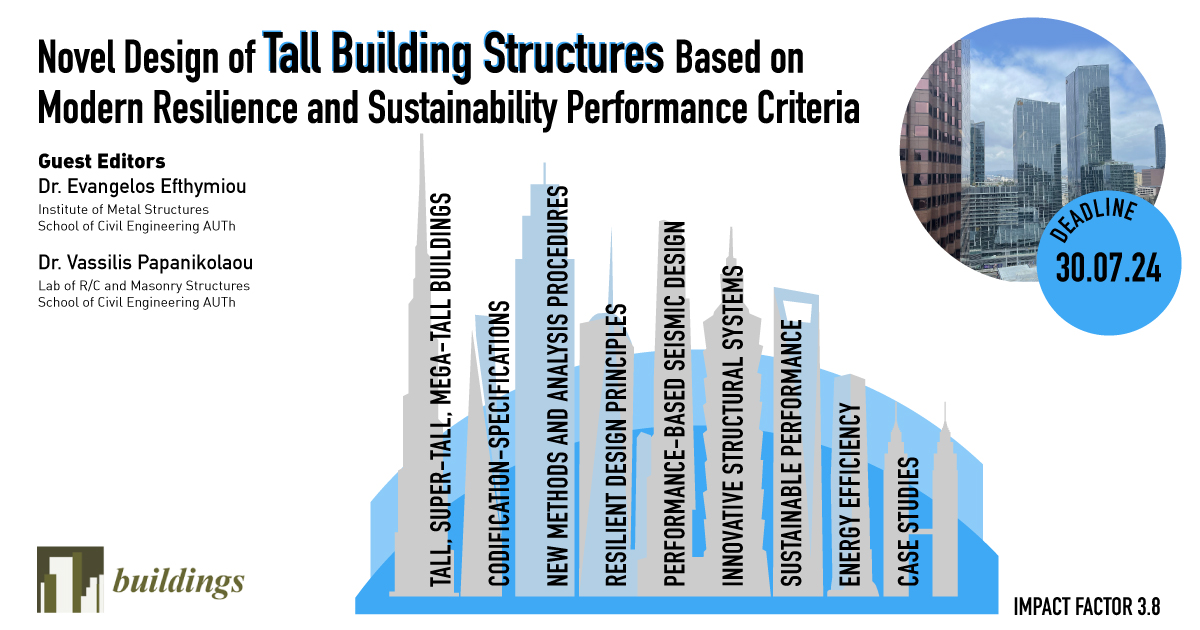Novel Design of Tall Building Structures Based on Modern Resilience and Sustainability Performance Criteria
A special issue of Buildings (ISSN 2075-5309). This special issue belongs to the section "Building Structures".
Deadline for manuscript submissions: 30 July 2024 | Viewed by 1957

Special Issue Editors
Interests: steel structures; standardization; structural aluminum; advanced analysis procedures; resilient design; high-rise buildings; sustainability assessment; refurbishment; wind energy applications
Interests: reinforced concrete; finite elements; computational engineering; earthquake engineering; experimental methods; embedded systems; structural monitoring
Special Issues, Collections and Topics in MDPI journals
Special Issue Information
Dear Colleagues,
In recent decades, the construction of tall buildings has significantly expanded as a result of material technology and scientific developments, combined with increased societal and financial needs for housing and commercial space in modern metropoles. According to the accepted terminology, tall buildings are typically defined as those exceeding 50 m in height, while super-tall refers to heights ranging from 300 m to 600 m and mega-tall to heights over 600 meters. In view of their special features, they are characterized by long periods of vibration and multi-modal response, while when it comes to earthquake resistance, nonlinear analysis procedures are employed, and innovative seismic resistant schemes are developed. Recently, intense research has been carried out towards the application of resilience and sustainability concepts in tall building design, addressing their failure–collapse impact and climate change effect, respectively.
This Special Issue is dedicated to current developments regarding novel design approaches of tall buildings (covering tall/super-tall/mega-tall types) that consider resilient and sustainable performance criteria.
We invite original contributions on new research, case studies, projects, reviews, and state-of-the-art discussions related to the design of steel, concrete, and composite steel–concrete tall buildings. Submissions may concern novel approaches in analysis methods and design practices, theoretical or applied research in the fields of civil engineering, building construction, and architecture engineering, accounting for contemporary resilience concepts and sustainability requirements.
We welcome papers on the following and related topics:
- Seismic design concepts—earthquake resistant/mitigation systems;
- Current codification provisions-specifications in tall building design;
- Wind loading effects;
- Finite element modeling and nonlinear analysis procedures;
- Performance-based design of tall buildings;
- Impact of building envelope—curtain wall contribution/resilience;
- Sustainable design of tall buildings;
- High-performance materials in tall building design and construction;
- Digital twin technology;
- Structural optimization of tall buildings;
- Case studies.
Dr. Evangelos Efthymiou
Dr. Vassilis Papanikolaou
Guest Editors
Manuscript Submission Information
Manuscripts should be submitted online at www.mdpi.com by registering and logging in to this website. Once you are registered, click here to go to the submission form. Manuscripts can be submitted until the deadline. All submissions that pass pre-check are peer-reviewed. Accepted papers will be published continuously in the journal (as soon as accepted) and will be listed together on the special issue website. Research articles, review articles as well as short communications are invited. For planned papers, a title and short abstract (about 100 words) can be sent to the Editorial Office for announcement on this website.
Submitted manuscripts should not have been published previously, nor be under consideration for publication elsewhere (except conference proceedings papers). All manuscripts are thoroughly refereed through a single-blind peer-review process. A guide for authors and other relevant information for submission of manuscripts is available on the Instructions for Authors page. Buildings is an international peer-reviewed open access monthly journal published by MDPI.
Please visit the Instructions for Authors page before submitting a manuscript. The Article Processing Charge (APC) for publication in this open access journal is 2600 CHF (Swiss Francs). Submitted papers should be well formatted and use good English. Authors may use MDPI's English editing service prior to publication or during author revisions.
Keywords
- tall, super-tall, mega-tall buildings
- codification-specifications
- new methods and analysis procedures
- resilient design principles
- performance-based seismic design
- innovative structural systems
- sustainable performance
- energy efficiency
- case studies






